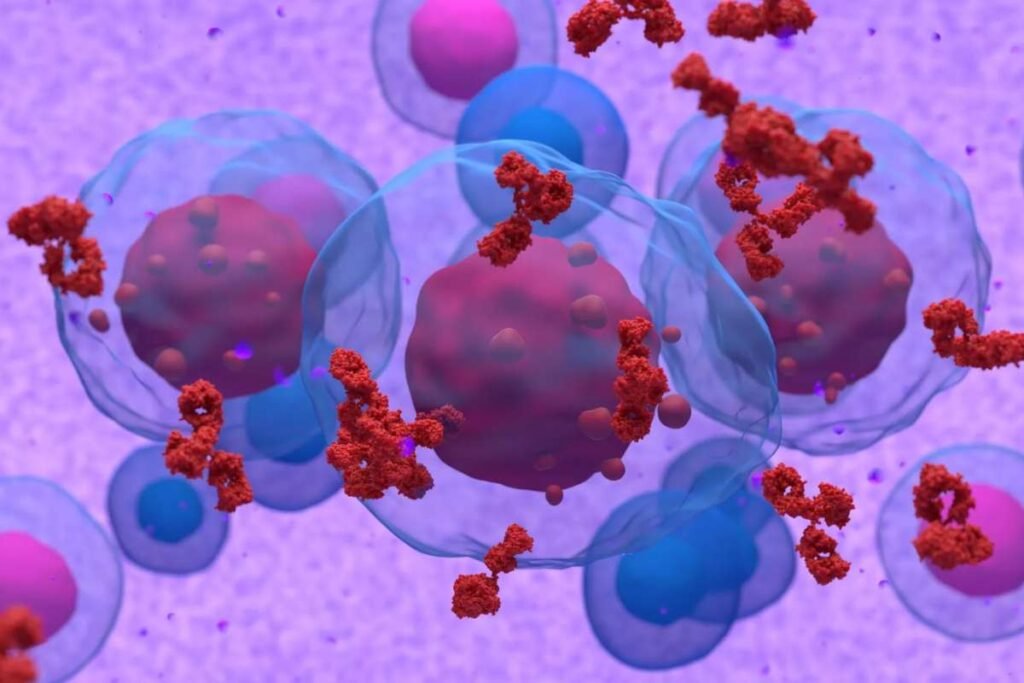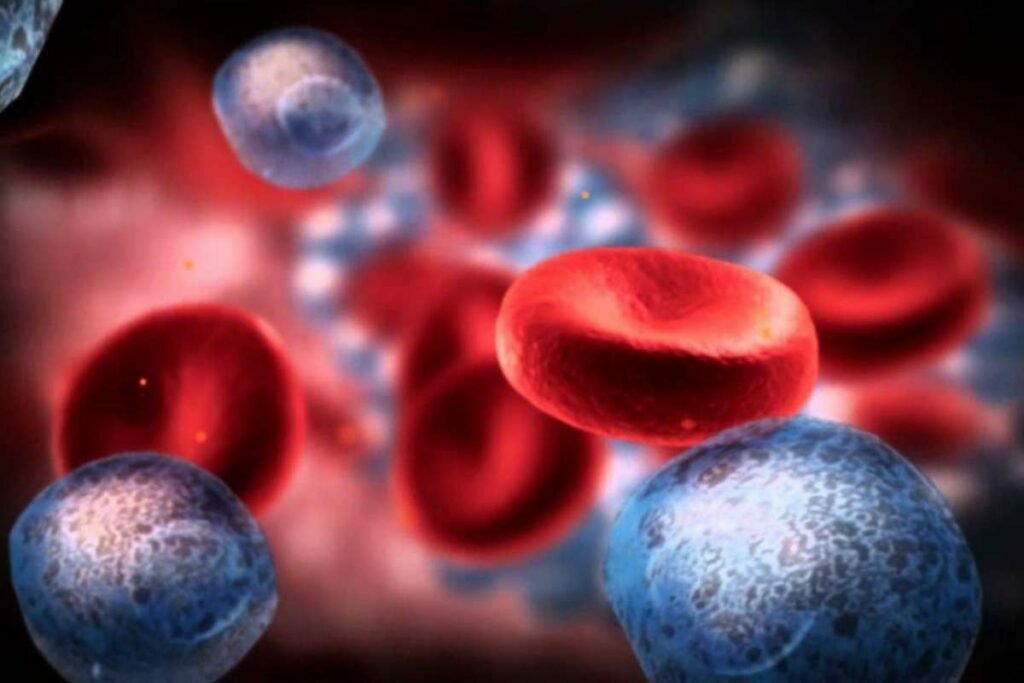Multiple myeloma is a type of blood cancer that affects plasma cells, which are responsible for producing antibodies. It is a rare but serious disease that can cause various symptoms and complications, such as bone pain, kidney damage, infections and anaemia.
If you or someone you love has been diagnosed with multiple myeloma, you may wonder about the best treatment options. How can you fight this disease and improve your quality of life? What are the latest advances and research in this field?
In this blog post, we will answer these questions and more. We will explain the first-line treatment of multiple myeloma, why it is important, what it involves, and what to expect from it. We will also share some tips and resources to help you cope with the challenges of living with multiple myeloma.

What is First-Line Treatment of Multiple Myeloma?
First-line treatment (sometimes referred to as induction therapy, primary therapy, or front-line therapy) is the first therapy that will be tried for all newly diagnosed myeloma patients. It is designed to reduce the number of myeloma cells in the body, control the symptoms and complications of the disease, and prepare the patient for further treatment options.
The choice of first-line treatment depends on several factors, such as the stage and risk category of the disease, the patient’s age, health status, preferences and goals. The first-line treatment may also vary depending on the availability and accessibility of certain drugs in different countries.
The main types of first-line treatment for multiple myeloma are:
- Chemotherapy: This involves using drugs that kill or stop the growth of cancer cells. Chemotherapy can be given orally (by mouth) or intravenously (through a vein). Chemotherapy drugs can be used alone or in combination with other drugs.
- Immunotherapy: This involves using drugs that stimulate or enhance the immune system’s ability to fight cancer cells. Immunotherapy drugs can be given orally or subcutaneously (under the skin). Immunotherapy drugs can be used alone or in combination with other drugs.
- Steroids: These are drugs that reduce inflammation and suppress the immune system. Steroids can be given orally or intravenously. Steroids can be used alone or in combination with other drugs.
- Stem cell transplant: This involves using high doses of chemotherapy to destroy the bone marrow (where blood cells are made) and then replacing it with healthy stem cells from the patient’s own body (autologous transplant) or from a donor (allogeneic transplant). Stem cell transplant can offer a chance of cure for some patients, but it also carries a high risk of side effects and complications.
The most common first-line treatment combinations for multiple myeloma are:
- VRd: This consists of Velcade® (bortezomib), Revlimid® (lenalidomide), and dexamethasone. Velcade is an immunotherapy drug that blocks the activity of a protein called proteasome, which helps myeloma cells survive and grow. Revlimid is an immunotherapy drug that belongs to a class called immunomodulatory drugs (IMiDs), which affect the immune system and the bone marrow environment. Dexamethasone is a steroid that reduces inflammation and enhances the effects of Velcade and Revlimid. VRd is recommended as the first-line treatment for patients who are eligible for stem cell transplants.
- VMP: This consists of Velcade, melphalan, and prednisone. Melphalan is a chemotherapy drug that belongs to a class called alkylating agents, which damage the DNA of cancer cells. Prednisone is a steroid that reduces inflammation and enhances the effects of Velcade and melphalan. VMP is recommended as the first-line treatment for patients not eligible for stem cell transplants.
- VTd: VTd consists of Velcade, Thalomid® (thalidomide), and dexamethasone. Thalomid is an immunotherapy drug that belongs to the same class as Revlimid (IMiDs) but has different side effects and benefits. VTd is an alternative option for patients who cannot tolerate or access Revlimid.
- VCd: VCd consists of Velcade, Cytoxan® (cyclophosphamide), and dexamethasone. Cytoxan is a chemotherapy drug that belongs to the same class as melphalan (alkylating agents), but it has different side effects and benefits. VCd is an alternative option for patients who cannot tolerate or access melphalan.
Other possible combinations of drugs may be used as first-line treatment for multiple myeloma, depending on the patient’s situation and doctor’s recommendation. Some examples are:
- Daratumumab (Darzalex®): This is an immunotherapy drug that belongs to a class called monoclonal antibodies, which target a specific protein on the surface of myeloma cells. Daratumumab can be used in combination with VRd, VMP, VTd, or VCd.
- Carfilzomib (Kyprolis®): This is an immunotherapy drug that belongs to the same class as Velcade (proteasome inhibitors), but it has different side effects and benefits. Carfilzomib can be used in combination with Revlimid and dexamethasone, or with Cytoxan and dexamethasone.
- Ixazomib (Ninlaro®): This is an immunotherapy drug that belongs to the same class as Velcade and Carfilzomib (proteasome inhibitors), but it is taken orally instead of by injection. Ixazomib can be used in combination with Revlimid and dexamethasone.

Why is First-Line Treatment of Multiple Myeloma Important?
First-line treatment of multiple myeloma is important because it can have a significant impact on the patient’s outcome and quality of life. The goals of first-line treatment are to:
- Achieve the best possible response: This means reducing the amount of myeloma cells and proteins in the body as much as possible, as measured by blood tests, urine tests, bone marrow tests, and imaging tests. The higher the level of response, the better the prognosis and the longer the survival.
- Prevent or delay disease progression: This means preventing or slowing down the growth of myeloma cells and the development of new symptoms or complications. The longer the disease stays under control, the better the quality of life and the more options for future treatments.
- Minimize or manage side effects: This means choosing a treatment that is effective but also tolerable for the patient, and addressing any adverse reactions or complications that may arise from the treatment. The lower the level of toxicity, the better the quality of life and the higher the adherence to treatment.
What Does First-Line Treatment of Multiple Myeloma Involve?
First-line treatment of multiple myeloma involves taking one or more drugs for a certain period of time, usually several months. The drugs may be given in cycles, which are intervals of treatment followed by intervals of rest. The duration and frequency of each cycle depend on the type and dose of drugs used.
The patient may need to visit the hospital or clinic regularly to receive some drugs by injection or infusion, or to have blood tests or other exams. The patient may also need to take some drugs at home by mouth or by injection. The patient may need to follow certain instructions regarding diet, hydration, medication, infection prevention, and symptom management.
The patient may experience some side effects from the first-line treatment of multiple myeloma, such as nausea, fatigue, hair loss, nerve damage, infection, bleeding, or bone loss. The patient may need to take additional drugs or supplements to prevent or treat these side effects. The patient may also need to seek medical attention if they develop any signs of serious complications, such as fever, chest pain, shortness of breath, or confusion.
The patient may need to undergo regular tests and scans to monitor their response to first-line treatment of multiple myeloma and their disease status. The patient may also need to communicate with their doctor and healthcare team about any changes in their symptoms, concerns, or preferences. The patient may need to adjust their treatment plan according to their results and feedback.
What to Expect from First-Line Treatment of Multiple Myeloma?
First-line treatment of multiple myeloma can be challenging but rewarding. It can offer hope and relief for many patients who suffer from this disease. It can also pose some difficulties and uncertainties for some patients who face this disease.
Here are some things you can expect from first-line treatment of multiple myeloma:
- You can expect to see some improvement in your symptoms and your blood counts after starting treatment. You may feel less pain, more energy, and more appetite. You may also notice a decrease in your myeloma proteins and an increase in your normal blood cells.
- You can expect to have some side effects from your treatment. You may experience some discomfort, fatigue, nausea, hair loss, nerve damage, infection, bleeding, or bone loss. You may also have some emotional distress, such as anxiety, depression, anger, or fear.
- You can expect to have some support from your doctor and healthcare team. They will guide you through your treatment plan and help you manage your side effects and complications. They will also monitor your response and adjust your treatment accordingly.
- You can expect to have some choices and options for your treatment. You can discuss with your doctor and healthcare team about your preferences and goals for your treatment. You can also seek a second opinion from a myeloma expert if you have any doubts or questions.
- You can expect to have some challenges and uncertainties for your treatment. You may face some difficulties with your finances, insurance, work, family, or social life. You may also wonder about your prognosis, your future treatments, or your chances of cure.
How to Make the Most of Your First-Line Treatment of Multiple Myeloma?
First-line treatment of multiple myeloma can be a life-changing experience for you and your loved ones. It can also be an opportunity to take charge of your health and well-being. Here are some tips to help you make the most of your first-line treatment of multiple myeloma:
- Be informed and involved in your treatment. Learn as much as you can about your disease and your treatment options. Ask questions and express your concerns to your doctor and healthcare team. Participate in shared decision-making and follow your treatment plan.
- Be proactive and positive in your treatment. Take good care of yourself by eating well, staying hydrated, exercising moderately, resting adequately, and avoiding infections. Focus on the benefits and the goals of your treatment rather than the drawbacks and the risks. Celebrate your achievements and milestones along the way.
- Be realistic and flexible in your treatment. Understand that your treatment may not work as expected or may cause some unwanted effects. Be prepared to deal with any changes or challenges that may arise. Be open to trying new or different treatments if needed.
- Be hopeful and grateful in your treatment. Believe that your treatment can make a difference in your life and that you can overcome this disease. Appreciate the support and the care that you receive from others. Find joy and meaning in the things that matter to you.
Conclusion
First-line treatment of multiple myeloma is a crucial step in your journey with this disease. It can help you control your disease, improve your symptoms, and prepare you for further treatments. It can also affect your quality of life, both positively and negatively.
By being informed, involved, proactive, positive, realistic, flexible, hopeful, and grateful, you can make the most of your first-line treatment of multiple myeloma. You can also seek help from various sources, such as your doctor, healthcare team, family, friends, or other myeloma patients and survivors.
We hope this blog post has given you some useful information and insights about first-line treatment of multiple myeloma.
Thank you for reading this blog post! Please share it with anyone who may benefit from it!





























